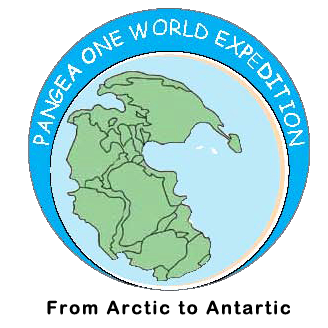
EXPEDITION ACCOUNTS
DOWN ALASKA MARINE HIGHWAY
Homer, on Cook Inlet of the Gulf of Alaska, is known for its "Spit" - a five-mile road stretching into the waters. A row of shacks selling fishing trips - the principal reason for coming to Homer - were still open for business while the cafes and restaurants had already closed for the season. Anglers bait salmon and over 250-pound Halibut. Chevron is exploring tidal resources in Cook Inlet to generate energy. Alaska has 90% of America's tidal potential and 50% of its wave potential. Glacial silt choking turbines, partial freezing of sea in winters, and endangered beluga whales are problems Chevron has had to contend with. Though Alaska's North Slope, where we were earlier, north of the Atigun Pass, has the largest oilfield in the US and the largest known gas reserves, the state, sitting on the Pacific Ring of Fire, has a huge potential in renewable energy.
On a bleak, dismal afternoon we boarded the ferry M/V Kennicott, named after the zoologist and explorer Robert Kennicott who led, in 1865, Western Union Telegraph Expedition to explore the interiors of Alaska for the purpose of laying a cable under Alaska and Bering Strait and connecting it to the Trans-Siberian cable. Though Kennicott died the following year and the cable was never laid, the wealth of scientific information provided by the expedition contributed to the decision to purchase Alaska from Russia in 1867. Rain and poor visibility made the mountains on both sides of the inlet look like apparitions. It was smooth sailing till the nearby Kodiak Island that was the epicentre of the mightiest recorded quake that has rocked North America (8.6M on Good Friday, 1964).
As we entered the Gulf of Alaska, the open sea was heaving and sighing. Our vessel started rolling and pitching, rising and falling, diving into the troughs and leaping over the waves. Stomachs felt queazy and most passengers, overcome by nausea, retired to their cabins or tents pitched on the upper deck. The ferry's modest restaurant and bar did not do much business that night. We slipped into our bunks and, taking deep breaths, laid in for 12 hours, sliding up and down our mattresses when the ship rolled sideways.
Bad weather continued all of next day and the rough sea gave us no respite. I spent some time with an artist from Homer who was looking for albatross that live on the open sea feeding on krills and fly back to land only to nest. In spite of his interest in ornithology, the man was geographically challenged and wasn't sure of India's location on a world map. "But then I am a sourdough," he said.
"You don't look like yeast-flour to me" said I, puzzled.
"Naw! That's what we call folks who have lived all their lives in the boondocks of Alaska," he clarified.
Later that day, I spotted some playful porpoises swimming along our ferry and the distinguished French-bearded cashier joined me in tracking them. I asked him if he was a "sourdough" - showing off my understanding of Alaskan speech.
"No. I am from the Lower 48," said he, in reference to the 48 contiguous American states.
"That artist I saw you talking to earlier in the day said he was a sourdough and seemed proud of it," said I.
"That's a lot of bull! He is probably sour on Alaska and lacks the dough to leave!"
The porpoises were still tossing around the ferry. "That's good omen," said the cashier. "Old sailor superstition. And that's not good omen," he said, pointing towards a ship's mechanic who was taking his chances with the two Swedish girls."In old times sailors believed that a ship that had women on board was doomed. They would distract men from the duties - as you can see. However, a naked woman could calm the seas. That is why many ships had a bare-breasted figurehead at the bow."
After sunset we steered off the Gulf and took the inside passage to Yakutat in calm waters of the strait hemmed between two mountain ranges.
"Where is the casino?" I asked a local on disembarking in Yakutat at 8 pm.
"There is none," said he. "We have only a bar and a general store. And they are both closed. Yakutat ran out of beer and milk three days ago."
After a short walk in the dark to stretch our legs, we returned to the ferry.
Leaving Yakutat, we once again sailed into the stormy Gulf of Alaska, tossing like dolphins in our beds all night.
Next morning the visibility was worse than the two previous days. Only a few passengers dared to step out on the deck and face the cold, violent wind and the arrowy tempest of rain. They were well attired in rainproof parkas, mufflers, gloves and woollen caps. But there were two - a young father and son - who would always come out to the deck in sleeveless T-shirts and jeans. I could not help asking them: "Are you guys Eskimos or reincarnated polar bears ?"
"Eskimos is right,"said the dad, laughing.
"A genuine Eskimo?" I wanted to know.
"No. Half. My mom is an Eskimo. She lives down on King Island."
Since my childhood I have worshipped Eskimos and Red Indians for their free spirit, their fiercely independent character, their outdoorsmanship and love of nature. Even this half-Eskimo was good enough to deserve my homage.
"And where are you headed?" I enquired.
"To Fresno, California, to meet my brother."
"Why? Is he in exile? Enslaved and insulted by the settlers?"
"No," he sniggered. "He teaches in a college."
"Teaches beadwork, fish oil processing, meat preservation , or...?"
"No. Physics."
"And how do you, sir, make a living? Hunting seals? Trading fur? Whaling? Making knives from walrus teeth perhaps?"
"No. I am a preacher in the Methodist church."
I readied to go on a warpath against the Eskimos.
Towards the afternoon, as we entered the calm blue waters of Icy Strait, the fog lifted to reveal the pure Alaskan wilderness of countless forest-clad islands; fjords, sound and passages watched over by a lofty chain of snow-capped mountains forested down to the water's edge. White seagulls sat of water like lilies in a pond. Humpback whales spouted fountains of bubbly water. Prying passengers spotted so many of them that they soon ceased to be a novelty. In the distance was Glacier Bay, at 3.3 million acres the largest protected marines sanctuary in the world and a World Heritage Site. As we approached Juneau the broad and far-reaching expanse of Mendenhall Glacier came into view - it's gaping, unwashed mouth, having swallowed miles of moraine, was ready to belch out, with a roar and a crash, mountains of bergs into the lake.
Leaning on the railing, next to us, was Tom Catterson, a retired professor of Environmental Sciences and Forestry from Syracuse University. He had spent five months in Khulna, Bangladesh, studying biodiversity in Sunderbans. He had also advised the Government of Gujarat in social forestry, conducted seminars on women and social forestry in Gangotri region of Uttarakhand, and visited Punjab. He had boarded the ferry in Yakutat where his son was a forester working with the state government, and was sailing to Juneau where his second son was studying marine biology. On climate change his immediate response was that glaciers were receding in Alaska. When I pointed out that this was nothing new - as in 1879 the great naturalist John Muir, during his explorations in Alaska, had calculated that the ice in Glacier Bay had receded 80kms since it was first measured by Capt. George Vancouver in 1794, the professor agreed with me. "The only thing I can say about climate change with some certainty is that the weather has become erratic. Can't say hotter or colder - just erratic," said he.
Juneau, the state capital of Alaska, can not be accessed by road. You can either fly or float. "It's our way of keeping our politicians in captivity. If they are allowed to run around the state,they will only create trouble," quipped a passenger from Anchorage.
The ferry docked 20km from town and as there was not enough time to reach the beautiful wharf, that I had visited on an earlier cruise. Instead, we walked 30 minutes to a bar, conveniently located next to the university bookstore, to avail of its free wifi service and check our mail. It was 9/11 and the nation was observing the 12th anniversary of the attacks. All flags, including that of our ferry, were flying on half-mast.
The next morning brought bright sunshine and beautiful views. In spite of its redundancy, the scenery is engaging, beguiling, fascinating. Docking in Ketchikan for three hours, we took a local bus downtown and made a fleeting visit to the picturesque shops on the waterfront near the cruise ship terminal and walked the Creek Street with its stilted houses from the Gold Rush period on a salmon-infested river. There a several large diamond shops on the wharf - mostly owned by Indians. Satish Mirpuri of Soni Jewellers informed us that the diamond trade in Alaska is dominated by Indians - Sindhis from the Caribbean. Born and raised in Chennai, he is a Sindhi himself and had migrated to St Kitts after graduating from college. Lower taxes in Alaska result in cheaper prices of diamonds and tanzanite. "This is a wholesale market for stones and the cruise ship passengers - already one million in the last four months since May - keep business ticking," he said, bowing to the stone idol of Ganesh.
Shortly after leaving Ketchikan, we met the western border of Canada and for the next day-and-a-half, till almost the end of our voyage in Bellingham in Washington State, we would be cruising along a thousand km of Canadian shoreline.
Soon we were engulfed by dense fog and zero visibility. That night the ship's crew was having a late-night party to celebrate Alaska Marine Highway System's 50th anniversary. I slept with my life vest on.
The fog did not lift till early afternoon the next day. There was an old couple on board. The man, an old warhorse in his 80s and still in good shape, sat quietly with his ailing wife all day long, lovingly holding her hand. The lady's chin stretched to her chest and her face was wrinkled with age. She was ancient beyond years and could have been the first sample of her race to have stepped upon the Alaskan wilderness. Placing her husband's hand on her lap, she would sit with her eyes closed as if saying her last prayers. When she was not saying her last prayers, she was downing her last Bloody Mary in a frantic hurry. That seemed to revive her enough to resume her knitting with the husband standing in front of her entangling the wool and winding it into a fresh ball - and then stepping back to watch her toil over her needles. His attention turned towards me and we got talking. He had been fishing near Homer for the last sixty years "when we could grab thousands of salmon by hand during low tide as they made their way over the shallows". But over the years their numbers had declined - "whether due to over-fishing or climate change - I can't say".
"However," he continued, "the salmon have been returning to Alaska in record numbers the last few years - probably because of the colder, wetter weather since 2008. The changed ocean conditions increased the availability of cold water plankton that have higher fat reserves and are favoured by the salmon." The wife had woken up and he rushed to the bar to get her favoured drink.
For me too it is mug up - time for grub and coffee - as the Alaskans say - and I gtg.





